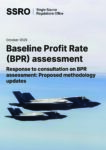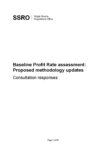This consultation has concluded
Detail of outcome
The SSRO is required each year to provide the Secretary of State with its assessment of the appropriate starting rate of profit on Ministry of Defence contracts placed in the absence of competition, known as the baseline profit rate (BPR). We have published the outcome of our recent consultation on developments to the annual profit rate assessment methodology on our website. The feedback received is outlined in the consultation response, alongside how it was considered by the SSRO when updating the methodology.
The BPR is the starting point for the agreement of contract profit rates and is 8.56 per cent for 2025/26. The BPR has been applied to contracts worth over £124 billion since April 2015. The BPR is only the first in a series of steps used by the contracting parties to derive the contract profit rate, which is typically higher than the BPR. Where contractors take on risk and perform well through the life of the contract, they can achieve even higher contract profit rates whilst those who fail to perform can earn less.
The BPR supports both value for money for taxpayers as well as fair and reasonable contract prices for contractors because it reflects the profits that companies contracting competitively earn when they undertake activities comparable to those that enable the performance of non-competitive defence contracts.
The SSRO launched a consultation in June 2025 based on two identified external developments and to conclude on the remaining proposals from the Phase 2 activities review consultation response from 2024. The purpose of the consultation was to ensure that the BPR methodology remains up-to-date, relevant and appropriate.
We consulted on proposals to:
- use the latest applicable Nomenclature of Economic Activities (NACE) codes database version NACE Rev. 2.1 for the BPR assessment when this becomes fully available for use. NACE codes are a European system of classifying economic activities for the purpose of statistical and other analysis.
- update the company size thresholds for identifying comparable companies for the BPR assessment to align with new regulations.
- withdraw the remaining changes proposed in 2024 which were to include technical support services in the BPR assessment and labour outsourcing in the Ancillary Services activity type.
The implementation of changes to the BPR methodology is contingent on the complete and correct adoption of NACE Rev. 2.1 in the Moody’s Orbis database, which is used as the source for company data. This is not fully available in time for the 2026/27 assessment and methodology update. Therefore, no changes have been made to the BPR methodology for the 2026/27 BPR assessment. We will incorporate the NACE code Rev. 2.1 database into the BPR methodology from the 2027/28 BPR assessment onwards.
The increase in company size thresholds will also be incorporated into the methodology from the 2027/28 BPR assessment onwards following the new company size thresholds coming into effect for companies with financial periods beginning on or after 6 April 2025.
The two remaining changes proposed in 2024 as part of the activities review relating to technical support services and labour outsourcing have not been taken forward at this time following stakeholder feedback and further SSRO analysis. This concludes the activities review.
By signalling these changes well in advance, the SSRO is providing clarity and predictability. This proactive and consultative approach demonstrates the SSRO’s ongoing commitment to continuous improvement of the single source regulatory framework, ensuring that the BPR remains appropriate, evidence-based, and reflective of current economic conditions.
We thank all those who responded to the consultation and for sharing their views. Where respondents gave permission, their responses have been published.
Summary
Consultation description
As part of determining the baseline profit rate (BPR) for non-competitive qualifying defence contracts and subcontracts, we identify benchmark comparable company profits using criteria stated in the published BPR methodology. Keeping this methodology accurate, up to date and reflective of appropriate comparators to ensure a fair and reasonable profit and contract price is critical to industries’ role in delivering the objectives of the Strategic Defence Review as well as ensuring value for money (VfM) for taxpayers. We are proposing amendments to the criteria used to select these companies in response to two external changes (detailed below). We are keen to hear our stakeholders’ views.
Each year we are required to provide the Secretary of State for Defence with an assessment of the BPR. The BPR is the first step of the four-step process in determining the contract profit rate (CPR) that applies in determining the price of Ministry of Defence (MOD) contracts let without competition, known as Qualifying Defence Contracts (QDCs) and Qualifying Sub-Contracts (QSCs): more commonly known as single source contracts. The BPR is only the starting point for agreeing contract profit rates, and contractors can, and do, earn significantly higher profit rates when they take on risk and perform well throughout the contract duration, but they can also earn less when they fail to perform. This structure can be applied to provide a strong incentive for suppliers to control risks and improve productivity to capture the gains of cost reduction as additional profit.
To arrive at the BPR, we have a robust BPR methodology – available on our website – which has been developed through stakeholder use and feedback over the past decade. We keep this BPR methodology up to date to ensure it remains appropriate and relevant: the BPR is a vital building block to delivering fast paced defence procurement of the most strategically significant capabilities for the nation, whilst ensuring value for money for taxpayers as well as providing a fair and reasonable price for contractors.
The methodology relies on selecting comparable companies to undertake the benchmarking that forms part of establishing the BPR, using codes from a classification system called NACE (Nomenclature of Economic Activities) which categorises businesses based on their economic activities. The NACE database has been updated recently, meaning the BPR methodology must be updated accordingly. Similarly, the BPR methodology has a company size threshold which filters out small companies and it is proposed that this aspect of the methodology is updated to remain consistent with the new UK regulations which revise the company size thresholds. We are also looking to conclude on the two remaining proposals from the previous BPR activities review phase 2 consultation from 2024 which were deferred pending further investigation.
We are consulting on these changes to keep the BPR methodology representative, up to date, and relevant to ensure we can produce a baseline profit rate which supports our aims of ensuring value for money and fair and reasonable prices whilst supporting the nation at this critical period.
Responding to the consultation
The consultation runs until 5pm Monday 11 August 2025. Written responses should be sent:
- to: consultations@ssro.gov.uk (preferred).
- Baseline profit rate consultation, SSRO, G51/G52, 100 Parliament Street, London, SW1A 2BQ.
If you would like to discuss any aspect of the consultation during the consultation period, please contact us on 020 3771 4767.




